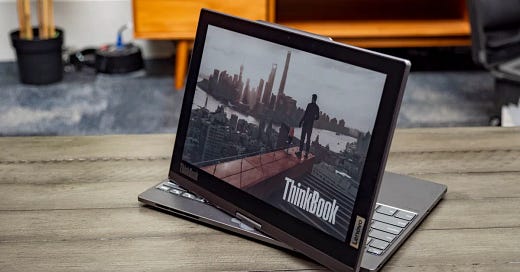Thinking beyond E Ink: Pixel Qi demonstrated the versatility of LCD screens
Pixel Qi's adaptive LCD approach is a superior alternative to the expansion of E Ink beyond its original remit.
One of the recent trends in consumer technology is the use of E Ink by prominent vendors in various scenarios. We have seen E Ink monitors, smartphones, tablets and smartwatches. Lenovo has released ThinkBook Plus Twist, which has a secondary colour E Ink display. The second E Ink display aims to provide an energy-efficient mode for saving battery life when, for example, viewing documents. Lenovo claims the colour E Ink display refreshes at 12Hz (the 12Hz refresh rate is probably in some speed mode with significant ghosting).
This is not the first laptop Lenovo released with a second E Ink display. Previously they released ThinkBook Plus and ThinkBook Plus Gen 2 - both these laptops had secondary monochrome displays.
While E Ink - with software optimisations - can be used in these different scenarios, there are drawbacks, and for many users, its use is untenable. At its core, E Ink is a bistable display technology, i.e., content is displayed even without a power source. Hence it is designed for static content that is primarily text and image-based.
Pixel Qi’s 3Qi display was one of the innovative LCD technologies that did not reach mass appeal. Between 2009 and 2010, it showed great promise as a flexible LCD technology that worked in three modes:
A transmissive mode that operates with the backlight activated.
A reflective mode that turns off the backlight to activate a power-efficient monochrome display that is also sunlight-readable.
A transflective composite mode that adapts the backlight based on external conditions. In this mode, the intensity of the backlight adjusts as the display reflects the external light for better viewability.
Pixel Qi’s adaptation of LCD is superior to E Ink in most scenarios noted above, as it generates better colour reproduction and similar refresh rates as transmissive LCD screens. In the case of Pixel Qi, there would be no need for a secondary display, as the backlight can be turned off when needed. Turning off the backlight is energy efficient, has eye health benefits and makes the screen easier to view outdoors.
There have been attempts to produce RLCD tablets - for example, Hisense Q5, TCL Nxtpaper S8 and Eyemoo NXT EPaper S1. SunVision Display also released a 32 inches RLCD monitor (considering the large size of the monitor, the resolution is a low 1920 X 1080). The closest to Pixel Qi is Eyemoo NXT EPaper S1 - an RLCD tablet with a front light that can be deactivated. Yet Pixel Qi’s approach is better due to its versatility, including the ability to operate with a traditional backlight that generates superior colour reproduction and clarity when needed.
Another positive of Pixel Qi 3Qi is its potential to be deployed in education, where a stable electric supply is not guaranteed. In 2010, Pixel Qi developed a partnership with the One Laptop per Child foundation in which its display technology could be used on their laptops.
The adaptation of LCD technology is not novel and has excellent potential if carefully developed considering use cases and deployment context. Pixel Qi 3Qi was an example of well-thought development in its clever use of LCD technology. Considering the inherent limitations of E Ink, adapting the backlight of LCDs to various use case scenarios is a more versatile and cost-effective solution.




